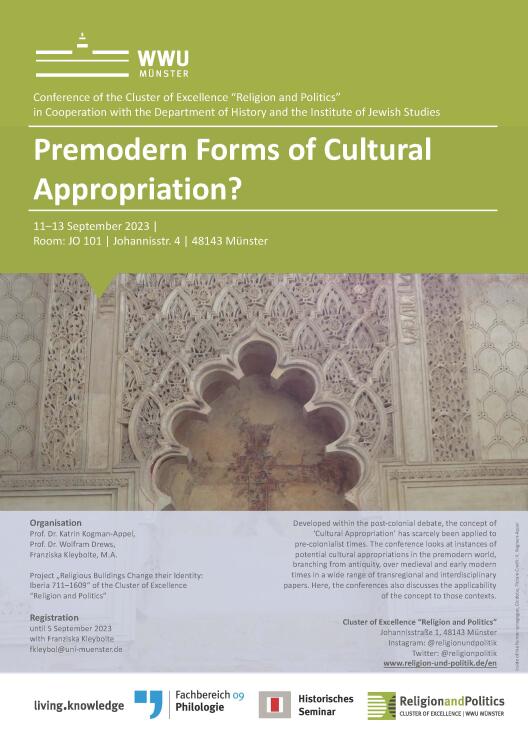Practices of “cultural appropriation” pervade epochs and regions
Research on the adoption of religious buildings and ideas – Case studies from the Mycenaean period to the Pacific region of the 17th century

Researchers at the Cluster of Excellence “Religion and Politics” are concerned with transcultural entanglements and disentanglements, and are currently investigating forms of “cultural appropriation” in premodern periods. Organized by the Jewish scholar Prof. Dr. Katrin Kogman-Appel, the medieval historian Prof. Dr. Wolfram Drews, and the medievalist Franziska Kleybolte, the international conference “Premodern Forms of Cultural Appropriation?” invited international researchers to discuss views on the issue. The lectures from the fields of history, Jewish studies, Egyptology, theology, and art history dealt with examples of potential “cultural appropriation” from the Mycenaean period to the Pacific region of the 17th century. An interview with Franziska Kleybolte:
What do you and your colleagues understand by “cultural appropriation”, and how does it arise?
The term “cultural appropriation” emerged in the post-colonialism debate in the 1970s and is now an integral part of discussions about racism, forms of colonialism, and the issue of the colonial past and reparations. It refers to the adoption of a material, but also immaterial, object, such as (religious) buildings, historiography, artistic elements of style, religious ideas – to name but a few. This adoption takes place in an unbalanced power relationship, often even a relationship of dependency, in which one group appropriates an object from another group perceived as foreign.
Through this relationship of dependency, appropriation is understood as a consciously or unconsciously chosen representation of this inequality, dominance, even oppression. Appropriation leads not only to a change of ownership, but also to a reinterpretation and thus an identitary change on the part of the object. This can lead to financial as well as social profit for the appropriators, and to a defamation of the group appropriated.
The conference showed that the perception of power relations can develop along different axes, although this does not always necessarily reflect the actual political power relations. A group can also feel culturally or religiously dominant or superior to another group that at the same time dominates it politically. This is a point that we continue to think about: how a group perceives itself and others; what, according to fixed criteria, would be understood as “cultural appropriation”; and what a group itself intends as “cultural appropriation”.
Can you give some examples?
At the conference, we talked for example about appropriation in Jewish and (Christian) religious architecture in the Rhineland of the 11th/12th century, appropriation in the transformation and deconstruction of mosques on the Iberian Peninsula under Christian rule, the conflict over mosques and Hindu temples in 12th-century India, and the use of indigenous languages by Spanish colonialists in Latin America. But we also talked about ethnic stereotypes in late medieval England and Ireland, when England tried to dominate and thus override Irish identities.
My own research project at the Cluster of Excellence is about the transformation of synagogues into Christian churches in the Kingdom of Castile in the 14th and 15th centuries. According to the definition above, this can be understood as “cultural appropriation”: the building was expropriated, the identity of the synagogues was explicitly reinterpreted, in parts there was a defamation of Jews and also of Judaism in these transformed spaces, and finally the Christians profited quite substantially from it: not only did they receive a new building and place of worship, but the Castilian king also often used the transfer of ownership to fill his own purse or to obtain the support of individual followers. The profits were thus of a financial, religious, and political nature.
The conference highlighted historical case studies from pre-modern, and also from pre-colonial times. Today, there is much discussion in the media about “cultural appropriation”, from carnival costumes to the adoption of musical styles. Is it the same phenomenon?
Historical comparisons are always problematic, since every constellation is unique and the implications are certainly different today. Also, the sources often do not allow such comparisons in the first place. But it is interesting that we can see criteria of the phenomenon being fulfilled over such a long period of time, and that the adoption and reinterpretation of objects has apparently been an established practice in many epochs and regions as a means to forge and perpetuate dominance and oppression.
Is such an adoption of objects from other cultures always discrimination against the minority concerned?
When we speak of “cultural appropriation”, this is certainly the case, and especially so if we understand the use of privilege and the explicit exploitation of political, economic, and social inequalities as a form of discrimination, too.
However, we can also see cases of appropriation between equal groups that arise from feelings of mutual interest and respect. Researchers speak here of “appropriation”, while the term “cultural appropriation” has established itself since the postcolonial turn to mean such appropriation in relations of dependency.
In my opinion, many processes, whether historical or contemporary, are certainly too freely labelled as “cultural appropriation”, and we need a precise examination of each historical constellation. Otherwise, we lose the chance to use the term to differentiate clearly between oppression and exclusion on the one hand, and interest and recognition on the other. Science is always concerned with neutrality. As scholars, it is not our task as scholars to evaluate historical developments, let alone actors or entire groups. The concept of “cultural appropriation”, however, is an attempt to describe and to problematize forms of dependency and oppression through the adoption of objects that have group-specific significance. (spi/vvm)

